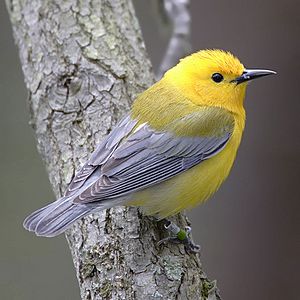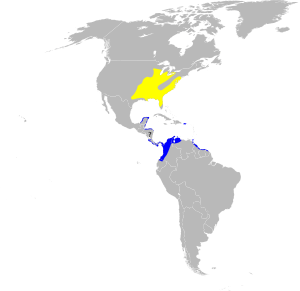Prothonotary warbler facts for kids
Quick facts for kids Prothonotary warbler |
|
|---|---|
 |
|
| Female | |
| Conservation status | |
| Scientific classification | |
| Genus: |
Protonotaria
|
| Species: |
citrea
|
 |
|
| Range of P. citrea Breeding range Wintering range | |
The prothonotary warbler (Protonotaria citrea) is a small, bright yellow songbird. It belongs to the New World warbler family. This bird is the only member of its special group, called Protonotaria. It's known for its beautiful golden color and often lives near water.
Contents
About the Prothonotary Warbler's Name
The prothonotary warbler was first described in 1779 by a French scientist named Georges-Louis Leclerc, Comte de Buffon. He studied a bird found in Louisiana. Buffon gave it the French name Le figuier protonotaire.
The bird was also shown in a beautiful hand-colored drawing by François-Nicolas Martinet. Later, in 1783, a Dutch naturalist named Pieter Boddaert gave it the scientific name Motacilla citrea.
Today, it's the only bird in its group, called Protonotaria. This group was named by the American naturalist Spencer Fullerton Baird in 1858. The name Protonotaria comes from a Latin word for a church official who wore golden-yellow robes. The word citrea means "citrine" or "lemon-yellow." This is why the bird was once called the "golden swamp warbler."
What the Prothonotary Warbler Looks Like
The prothonotary warbler is about 13 centimeters (5 inches) long. It weighs about 12.5 grams (0.4 ounces). Its wingspan is around 22 centimeters (8.75 inches).
This bird has an olive-colored back. Its wings and tail are blue-grey. The underside of its body is yellow. It has a fairly long, pointed beak and black legs.
Adult male prothonotary warblers have a very bright orange-yellow head. Females and younger birds are a bit duller. Their heads are more yellow. When they fly, their short, wide tail looks special. It has two colors: white at the bottom and dark at the tip.
Where Prothonotary Warblers Live
Prothonotary warblers build their nests in hardwood swamps. You can find them in extreme southeastern Ontario and the eastern United States.
When winter comes, these birds fly south. They spend the colder months in the West Indies, Central America, and northern South America. Sometimes, a few birds might wander far from their usual areas. They have been seen in western states like California.
Prothonotary Warbler Behavior and Life Cycle
The prothonotary warbler is special because it's the only eastern warbler that nests in holes. It uses natural holes in trees or even old holes made by woodpeckers.
The male warbler often starts building several nests in his area. However, the female is the one who finishes the real nest. She then lays 3 to 7 eggs inside.
These birds like to find food in thick, woody areas near streams. They actively search for insects and snails in the low branches and leaves.
The song of this bird is loud and clear. It sounds like sweet-sweet-sweet-sweet-sweet. Their call is a loud, dry chip sound. When they fly, they make a loud seeep sound.
Status of the Prothonotary Warbler
The number of prothonotary warblers is going down. This is mainly because their habitat (the places they live) is being lost.
Another problem for them is the brown-headed cowbird. Cowbirds lay their eggs in other birds' nests, including the warbler's. This is called brood parasitism. The cowbird chicks then often outcompete the warbler chicks for food. Also, house wrens sometimes compete with them for nesting spots.
Because of these challenges, the prothonotary warbler is listed as endangered in Canada. However, in some protected places, like South Carolina's Francis Beidler Forest, there are many pairs of these birds. It's one of the densest known populations.
Prothonotary Warblers in Culture
The prothonotary warbler became well-known in the 1940s. This happened during a famous hearing in the House Un-American Activities Committee. A man named Whittaker Chambers said that another man, Alger Hiss, enjoyed bird-watching. Chambers mentioned that Hiss once talked about seeing a prothonotary warbler. When Hiss later talked about the same bird sighting, it helped show that the two men knew each other.
This bird is also mentioned in the book A Sand County Almanac by Aldo Leopold. He called it the "Jewel of my disease-ridden woodlot." He used the bird as an example of how dead trees become living animals.
John James Audubon painted a prothonotary warbler. This painting is the third one in his famous book The Birds of America.
In Kurt Vonnegut's novel Jailbird, the warbler is described as "the only birds that are housebroken in captivity."
Gallery
-
Painting by John James Audubon
Prothonotary warbler species account at Neotropical Birds (Cornell Lab of Ornithology)
See also
 In Spanish: Reinita cabecidorada para niños
In Spanish: Reinita cabecidorada para niños






